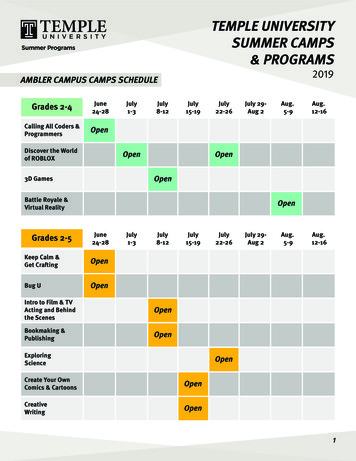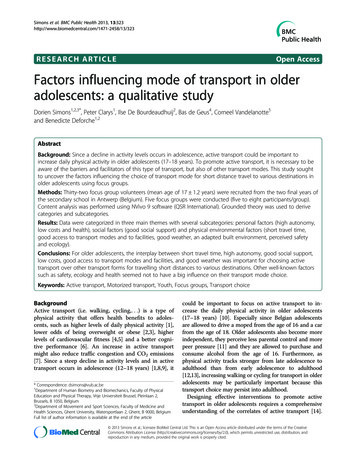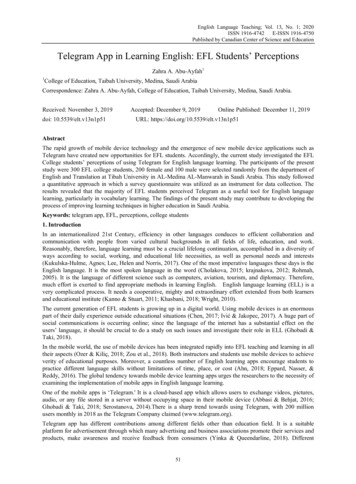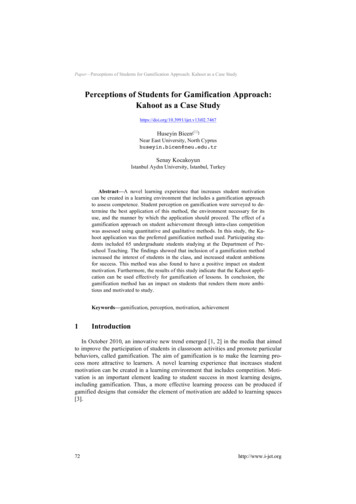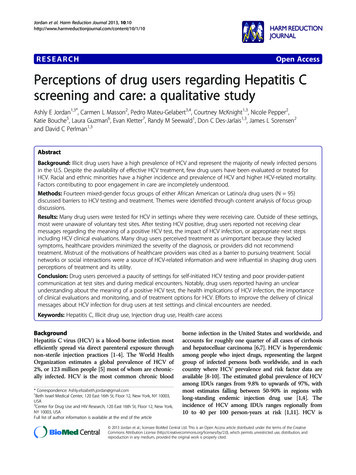
Transcription
Jordan et al. Harm Reduction Journal 2013, 0/1/10RESEARCHOpen AccessPerceptions of drug users regarding Hepatitis Cscreening and care: a qualitative studyAshly E Jordan1,3*, Carmen L Masson2, Pedro Mateu-Gelabert3,4, Courtney McKnight1,3, Nicole Pepper2,Katie Bouche5, Laura Guzman6, Evan Kletter7, Randy M Seewald1, Don C Des-Jarlais1,3, James L Sorensen2and David C Perlman1,3AbstractBackground: Illicit drug users have a high prevalence of HCV and represent the majority of newly infected personsin the U.S. Despite the availability of effective HCV treatment, few drug users have been evaluated or treated forHCV. Racial and ethnic minorities have a higher incidence and prevalence of HCV and higher HCV-related mortality.Factors contributing to poor engagement in care are incompletely understood.Methods: Fourteen mixed-gender focus groups of either African American or Latino/a drug users (N 95)discussed barriers to HCV testing and treatment. Themes were identified through content analysis of focus groupdiscussions.Results: Many drug users were tested for HCV in settings where they were receiving care. Outside of these settings,most were unaware of voluntary test sites. After testing HCV positive, drug users reported not receiving clearmessages regarding the meaning of a positive HCV test, the impact of HCV infection, or appropriate next stepsincluding HCV clinical evaluations. Many drug users perceived treatment as unimportant because they lackedsymptoms, healthcare providers minimized the severity of the diagnosis, or providers did not recommendtreatment. Mistrust of the motivations of healthcare providers was cited as a barrier to pursuing treatment. Socialnetworks or social interactions were a source of HCV-related information and were influential in shaping drug usersperceptions of treatment and its utility.Conclusion: Drug users perceived a paucity of settings for self-initiated HCV testing and poor provider-patientcommunication at test sites and during medical encounters. Notably, drug users reported having an unclearunderstanding about the meaning of a positive HCV test, the health implications of HCV infection, the importanceof clinical evaluations and monitoring, and of treatment options for HCV. Efforts to improve the delivery of clinicalmessages about HCV infection for drug users at test settings and clinical encounters are needed.Keywords: Hepatitis C, Illicit drug use, Injection drug use, Health care accessBackgroundHepatitis C virus (HCV) is a blood-borne infection mostefficiently spread via direct parenteral exposure throughnon-sterile injection practices [1-4]. The World HealthOrganization estimates a global prevalence of HCV of2%, or 123 million people [5] most of whom are chronically infected. HCV is the most common chronic blood* Correspondence: Ashly.elizabeth.jordan@gmail.com1Beth Israel Medical Center, 120 East 16th St, Floor 12, New York, NY 10003,USA3Center for Drug Use and HIV Research, 120 East 16th St, Floor 12, New York,NY 10003, USAFull list of author information is available at the end of the articleborne infection in the United States and worldwide, andaccounts for roughly one quarter of all cases of cirrhosisand hepatocelluar carcinoma [6,7]. HCV is hyperendemicamong people who inject drugs, representing the largestgroup of infected persons both worldwide, and in eachcountry where HCV prevalence and risk factor data areavailable [8-10]. The estimated global prevalence of HCVamong IDUs ranges from 9.8% to upwards of 97%, withmost estimates falling between 50-90% in regions withlong-standing endemic injection drug use [1,4]. Theincidence of HCV among IDUs ranges regionally from10 to 40 per 100 person-years at risk [1,11]. HCV is 2013 Jordan et al.; licensee BioMed Central Ltd. This is an Open Access article distributed under the terms of the CreativeCommons Attribution License (http://creativecommons.org/licenses/by/2.0), which permits unrestricted use, distribution, andreproduction in any medium, provided the original work is properly cited.
Jordan et al. Harm Reduction Journal 2013, 0/1/10also transmitted sexually among men who have sexwith men, often in association with non-injection illicitdrug use [12,13].HCV causes chronic infection with persistent viremiain the majority of those infected ( 85%) [14]. As a result,chronically infected persons constitute a significant reservoir of HCV creating an environmental transmissiondynamic that increases the probability that a non-sterileinjection episode will be with a chronically HCV-infectedperson [1,11]. Important sequelae of chronic HCV are liverfibrosis leading to cirrhosis; liver failure; and hepatocellularcarcinoma [15]. Studies suggest that over the course oftwo decades, 20-30% of chronically HCV infected personswill develop cirrhosis, with an estimated 10,000-20,000early deaths [14]. In the United States, the disease burdenis predicted to increase up to 3-fold over the course of thenext 10–20 years [15]. The efficacy of HCV treatment hasimproved in recent years with the introduction of directacting antivirals (e.g., telaprevir and boceprevir) and theprospect of interferon-free regimens [16,17]. For many,fear of adverse effects of HCV treatment is a barrier totreatment initiation and may contribute to treatment nonadherence and treatment discontinuation [18-21]. WhileHCV treatment has the potential to cure the virus in 4080% of patients, current treatment is arduous, lengthy, expensive and remains inaccessible for many drug users [15].The majority of drug users remain out of HCV care,and few are engaged in treatment [18,21-24]. ManyHCV positive drug users have not been evaluated forHCV treatment; are less likely to see an HCV specialistor to get an HCV RNA polymerase chain reaction (PCR)test to document chronic active infection; and are lesslikely to be receiving antiviral treatment for HCV compared to non-injection drug users [18,21,25]. Active druguse has been shown to not have a direct, negative effecton treatment efficacy [8,9,26-28]. It is estimated that lessthan half of drug users with chronic HCV have been offered treatment ever [17].Racial/ethnic minorities are less likely to receive antiretroviral therapy for HIV [29,30]. Some prior qualitativestudies have highlighted drug users’ misconceptions andlack of understanding about HCV, racial and ethnic minorities have a higher incidence and prevalence of HCVand higher HCV-related mortality [18,31-35]. Drug usersoften have limited access to health care and may experience or perceive stigmatization that poses a barrier to care[23,35]. Additionally, some drug users report that druguse-related stigma is a barrier to HCV testing. Rates ofHCV are higher in racial/ethnic minority drug users [36].Further data to inform the delivery of clinical messagesabout HCV infection for drug users at test settings andclinical encounters are needed.This study sought to explore racial/ethnic minority drugusers’ attitudes, perceptions, and experiences regardingPage 2 of 8HCV and HIV testing, referrals and treatment, throughfocus groups with drug users in San Francisco and NewYork City. This paper presents data regarding HCV testing and care.MethodsStudy participantsFourteen focus groups with a total of 95 participantswere conducted in New York City (6 focus groups) andSan Francisco (8 focus groups) in three recruitment settings: HIV primary care clinics, methadone maintenancetreatment (MMT) programs and syringe exchange programs (SEP). During the course of the study, the HIVclinics both conducted HCV testing and the site in NYCprovided on-site HCV treatment; the MMT programsoffered anti-HCV testing, but neither viral load testingnor HCV treatment; and the SEPs did routinely offerHCV testing but offered no on-site HCV care. Eligibilitycriteria required that participants be 18 years of age orolder; self-identify as African-American or Latino/a; andbe receiving services at one of the recruitment sites. Participants were excluded from the study if they had severecognitive impairment, suicidal ideation, or active psychosis.The study included persons who have used illicit drugs inthe past 12 months by either injection or non-injectionroutes; non-injection illicit drug users were included because of data demonstrating rates of HIV in noninjectors comparable to injectors in many cities [3] andbecause of concerns of HCV transmission via drugusing paraphernalia and networks [1]. The terms ‘drugusers’ and ‘injection drug users’ (IDUs) are usedthroughout the text where appropriate. This manuscriptreports on findings with respect to HCV testing andtreatment. This study was approved by the InstitutionalReview Boards of Beth Israel Medical Center and theUniversity of California, San Francisco.Participants were recruited through staff referrals ateach of the recruitment sites regardless of HCV status orprior testing experience. Participants were told that thegoals of the focus group were to explore participants’ experiences with HIV and HCV testing and care. Thenumber of participants in each group ranged from 3 to12. All focus groups were of homogenous race/ethnicity,consisting of either Latino/a or African American participants. The rationale for race/ethnicity specific focusgroups was to identify possible race/ethnicity specific issues with regard to HIV and HCV testing and care. Allfocus groups were conducted in English. Participantsprovided informed consent and were reimbursed 25 fortheir participation in the study.Focus groups were conducted by PhD-level qualitativeresearchers, bi-lingual in English and Spanish; eachgroup lasted roughly 90 minutes. The focus groups useda semi-structured qualitative interview guide designed to
Jordan et al. Harm Reduction Journal 2013, 0/1/10explore, in-depth, the following specific thematic areasrelated to HIV and HCV including: self-perceived risk;general knowledge of the viruses; prior experiences andcurrent feeling about seeking testing; prior pre- andpost-test experiences; and prior experiences accessing orremaining engaged in treatment. Further, the interviewguide also included open ended queries about individual’s drug use histories, knowledge of their own HIV/HCV status, and perceptions about race/ethnicity inrelation to testing and care (the focus group guide isavailable from the corresponding author). Participantsrecruited for these focus groups were not tested serologically: those recruited from HIV clinics were knownto be HIV infected; for others HIV status was by selfreport; and for all, HCV status was self-reported. 39%reported HIV infection (21% of the total reported HCV/HIV co-infection), 36% reported HCV mono-infection,and the rest reported unknown status. All focus groupswere audio taped and transcribed verbatim.Qualitative data analysisTranscripts were coded and analyzed using Atlas.ti V.5software. At least two researchers individually reviewedand independently coded all transcripts and discussedambiguities. Grounded theory [37] analytic techniqueswere used to seek patterns in the data and to developemergent hypotheses about them. Analysis began bycoding verbatim references containing any of the following codes: HCV/HIV testing, access to HCV/HIVcare, HCV/HIV treatment, racial/ethnic minority status, co-infection and drug user status. Two emergingcodes were added during the analysis: “medical mistrust” and “stigma”.ResultsFourteen focus groups were conducted, 6 in NYC and 8in San Francisco. The 6 in NYC included one withLatino/a participants and one with African Americanparticipants at each of the three recruitment settings(MMT, SEP, and HIV clinic) with a total of 51 participants. The 8 in San Francisco included 2 with AfricanAmerican and 1 with Latino in MMT; 2 Latino and 1African American at HIV primary care; and 1 AfricanAmerican and 1 Latino at SEP, with a total of 44 participants. The total sample of 95 participants was 41% female (n 39); average age was 45 years (minimum 32,maximum 58). The analysis discusses results related toaccess to HCV testing, post-test counseling and medicalcare, experience with HCV treatment and perceptions ofHCV treatment. No differences between testing experiences emerged by gender or between focus groups inNYC and San Francisco hence, results are reported inaggregate.Page 3 of 8HCV testingIn focus groups, nearly all participants reported havingbeen tested for HCV. Participants generally described anHCV testing experience that consisted of testing at thestructured settings in which they were receiving care,with tests commonly having been initiated by health careproviders with knowledge of participants’ risk factors forHCV. The primary settings in which participants weretested for HCV were MMTs and SEPs. Common tothose who were or had been in MMT was a perceptionthat routine HCV testing was a mandatory componentof the intake exam and annual physicals for all MMTpatients: “You’re on methadone, it’s a requirement anyway, to get tested for [HCV]” (African American male);no one reported objecting to being tested for HCV inthis way. This perceived routinization of HCV testing wasalso reported by participants who underwent testing athealth care sites where tests were usually initiated byhealth care providers and where the reason for the appointment was to receive care for other illnesses: “I did[HCV] testing when getting [treatment for] pneumonia”(Latino). Such testing often took place without participants being aware that they were tested for HCV: “I foundout afterwards [that I was tested for HCV]. [The doctor]tested it on his own”. (Latino).While testing for HCV was common among focusgroup participants, most reported being unaware of voluntary testing sites. Most participants were eager to haveaccess to voluntary HCV testing. Focus group participants did not report seeking self-initiated HCV testingoutside of MMT, SEP, jail and HIV primary care settings:“Most people just don’t know where to do it [HCV test],unless you go to the exchange and they happen to bedoing it there” (African American male); “You have tofind a way to get it [HCV test]; It ain’t like-come andget a hep C test. It’s like a best-kept secret” (AfricanAmerican male).Underscoring the reality that HCV is a widely asymptomatic disease, only one participant reported seekingmedical attention because they experienced symptomsassociated with an HCV infection: “I had yellow jaundice. Like my urine was orange, real dark orange [ ] Atleast the doctor told me [I was HCV positive]” (AfricanAmerican female).These patterns of HCV testing experiences contrastedwith participant reports regarding HIV testing, whichwere characterized by frequent and self-initiated testingwith access to ubiquitous testing sites: “HIV testing ismuch more accessible to me, more accessible than hepatitis C” (African American female). Participants had ahigh degree of awareness of available HIV testing sites:“The fact that they’re so accessible, I feel like if any day Ifeel like getting up and going to get [an HIV] test, I canget it the very same day” (Latina). Many participants
Jordan et al. Harm Reduction Journal 2013, 0/1/10reported self-initiated HIV testing every three to sixmonths.Experiences with HCV post-test counseling and referralsDespite their individual histories of drug use, many participants were surprised when they were first diagnosedwith HCV: “My doctor took blood, and he tested it andhe told me I had hepatitis C, and that was my first timeknowing about it [ ] I was an injector”. (AfricanAmerican male)Many participants found to be HCV positive reportedreceiving their results but coming away from post-testcounseling without a clear understanding of the significance of the diagnosis or what next steps to take: “Ifound out I was hep C positive. [The doctor] told methe basics but they never really told me what the nextstep was”. (Latino) Participants reported confusion anduncertainty given their new situation: They had beengiven a diagnosis of HCV, but did not come away with aclear understanding of the health implications or whatto do next:You’re hep C positive, but now what? they shouldhave a place to send them or I should have somebodysome place at my facility to at least counsel them.Nobody has even spoken to them. (African Americanmale)They won’t refer you to nobody, see they just told meand just left me hanging. Just left me there. (AfricanAmerican female)They didn’t give me nothing to go on. I had nothingto take home with me and sit down and study and goover myself they don’t have nothing for the poorperson that has contracted hep C. Nobody where Igot tested at gave me any literature. (AfricanAmerican female)Accompanying the feelings of uncertainty regarding anHCV diagnosis, many participants described feeling fatalistic with a generalized nihilism about managing theirinfection: “I don’t know what to do. Except just walkaround dying from it” (African American male).Participants specifically described a lack of explanationand clarity regarding the treatment options for HCV andthey were eager for more information and a better understanding of HCV treatment: “When I first found outI had hepatitis C, they didn't suggest any kind of treatment. It was only two or three years later that they mademe an appointment for the hospital to go” (Latina).As part of this uncertainty about treatment, manypeople came away with an implicit message that therewas not much else that could or needed to be done toPage 4 of 8treat HCV or to prevent liver damage. As one participantexplained: “Everybody says there’s really nothing too muchto do when you got that [HCV]. They just say, yeah, I gotit, as far as hep C, and they [health care providers] just letyou know” (African American male). Participants alsoreported disengaging from care once they found out theyweren’t eligible for treatment or that treatment wasn’t necessary for them at that point in time.So he told me that if you want, take a biopsy if youwant it, that was my option. So I didn't do it. He said,but your liver seems like it's okay. The numbers are in agood-good place [ ] So I dropped it at that. (Latino)Some participants, despite having been told they wereHCV positive, did not believe they were infected becausetheir providers did not offer them treatment: “I don't believe them [the doctors] for the simple fact they didn'tgive me, they didn't give me no medicine for it [HCV]”;“I’m sure he will if I have hep C, he will tell me take thisand this medication. He will order it. So I do not believeI have hep C” (African American male).Experiences with HCV treatment evaluationsAmong participants who reported receiving HCV treatment evaluations, many said that they were told byhealth care providers that due to the healthy state oftheir liver and the results of various tests to assess theirinfection, treatment was not recommended at that time.Some understood that treatment was not offered because there was no evidence of liver damage. Many participants reported not initiating HCV treatment becausetheir providers either did not discuss or recommend it:“My doctor told the same thing that everything was fine,not to worry about it [HCV] [ ] that the numbers werelow and that I didn't need no medication or anything”(Latina); “[My doctor told me] I didn’t need a treatmentbecause it wasn’t bad [ ] My liver wasn’t inflamed, andI was doing okay [ ] there was no need for medicationuntil years down the line” (African American male).While some people came away from HCV evaluationsunderstanding that treatment was indicated if there wassubstantial liver damage and may not be otherwise necessary, many participants did not have a thorough understanding and felt as if they were left in limbo with apositive diagnosis without clear options. Participants whowere evaluated but not offered treatment commonlyreported being counseled about reducing drug and alcoholuse and avoiding excess acetaminophen, “[the doctor] toldme that [ ] just don't drink any alcohol and don't abusethem, stuff that's going to irritate the liver”. (Latino)There were few participants who reported being encouraged to have regular medical follow-up to monitor
Jordan et al. Harm Reduction Journal 2013, 0/1/10their HCV infection but without recommendation fortreatment.I went according to my doctor. He said that my viralload was okay, so I took—I took it like that, okay, sothen I'm fine. Every month, you go see that doctor[ ] on a monthly basis and stay—stay with bloodwork. (Latino)Few participants in the focus groups had initiatedHCV treatment; however, of those who reported initiating treatment, they all discontinued treatment due to adverse drug reactions.I decided to treat it [HCV] [ ] I only did it for likefour months because I ended up getting some sideeffects [ ] The medication was doing things that Idislike [ ] I told [my doctor] that I am not taking itanymore. (Latino)For the participants who reported being offered treatment, many reported that the low odds of eradicatingthe virus deterred them from initiating treatment. Additionally, one participant reported that their provider didnot recommend treatment saying the patient wasinfected with an HCV genotype that was poorly responsive to treatment.Perceptions of HCV treatmentKnowledge and perceptions about HCV treatment oftencame from peers, and the messages communicated wereoften discouraging of treatment. While a few patientshad previously initiated HCV treatment, most had nodirect treatment experience. Participants reported thatthese communications with peers raised anxiety aboutthe potential adverse side effects of the medication: “Ididn’t even know what the process was [ ] I found outthrough someone who had hep C, and her experiencethrough it” (Latino).Participants with HCV were uniformly eager to learnmore about HCV treatment and how to stay healthy.Among participants who reported discussing treatmentwith a health care provider, or who were offered treatment, the majority felt dissuaded from pursuing it.While some participants reported an interest in treatment, the consideration of “everything that goes with it”,including not wanting to endure the serious side effectsof treatment, was the primary reason that participantschose not to initiate treatment. Among HCV-positive individuals in particular, there was a common perceptionthat HCV treatment was worse than the disease due tothe difficulty in coping with the length of treatment andmedication side effects: “[There are] bad reactions that alot of people have with medication. Some people getPage 5 of 8suicidal, depression [ ] They’d get lonely, you know, depressed, big, big stay of depression” (Latino).Many participants while willing and even eager to consider HCV treatment, many articulated that these fears oflengthy treatment and severe adverse effects- discouragedthem from pursuing treatment. Additionally, participantsreported believing that treatment might be harmful totheir liver, might cause HCV infection or other harmfulphysical adverse effects, and be inefficacious: “InterferonI’ve heard is the treatment for it but I’ve heard that thetreatment is worse than the disease and it’s not effective”.(Latino) Such concerns lead many infected but asymptomatic participants to not seek treatment; as one participant explained it: “if it ain’t broke, don’t fix it” (AfricanAmerican male). This attitude was common; participantsreported believing that it was more advantageous to theirhealth to not seek treatment rather than pursue treatmentand risk making their health worse: “my liver function isstill good, so I’m not going [to] take something that’s going [to] make me worse” (Latino).In contrast, across focus groups, participants’ overallknowledge about HIV and treatment options was extensive, regardless of their HIV status. Participants understood opportunistic infections; various tests indicatingHIV/AIDS status; treatment outcomes; and the necessityof treatment to control the infection “If you’re told yougot HIV [ ] it’s not like before, like it’s more manageable,you can live longer [ ] there’s so many drugs that canhelp with it”. (Latina)In addition to their individual concerns about HCV,participants also regarded HCV as a virus infecting andaffecting drug users rather than non-drug users. Theyconcluded that the paucity of HCV services and thelack of effective treatment options were the result ofstigma and marginalization of IDUs. In addition, participants described their belief that socioeconomicfactors and insurance availability influenced their doctors’ decision making regarding the provision of HCVtreatment.If you have private insurance [ ] They’ll give you allthe treatment and health that you want but becausethey know that Medicaid is not going to pay themtheir money on time- they’re going to get paid [ ]they’re not ready and willing to offer this treatment[to those with Medicaid]. (Latino)I think a lot has to do with – people who – thepowers that be don’t use drugs like we use drugs. It[HCV] don’t affect them. (African American male)One participant explained that she felt mistreatedby her doctor: “They kick you to the side”. (AfricanAmerican female)
Jordan et al. Harm Reduction Journal 2013, 0/1/10Mistrust of health care providers’ motivationsmanifested in other ways. Some participants reportedbelieving that their providers were diagnosing, and evenmisdiagnosing HCV to receive insurance payments fortheir visits.Implications of drug useOne of the barriers participants reported complicatingengagement in HCV care was active drug use. Participants reported that when they were using actively theywere less likely to get tested for HCV, “Personally, Iwouldn’t put down no syringe [ ] to go get tested [forHCV]” (Latino); “It took me so long [to get tested]because I was getting high”. (Latino) One participantexplained that her commencing HCV care occurred “fastas my addiction would let me go”. (African American female) Active drug use not only emerged as a barrier toparticipants’ willingness to engage in HCV testing, butalso as a barrier to clinical follow-up after receiving aHCV diagnosis. Participants reported that the consumingnature of drug use precluded any motivation to seek care.One participant attributed his active heroin use to his inability to schedule an appointment for an HCV evaluationfrom a referral he received after being tested for HCV:Yes, [the doctor] told me numerous times. I justdidn’t do it. Either I forgot about it or was just toolazy to get up off my ass and go do it. I got a thingabout keeping appointments [ ] it’s the dope’s fault.(African American male)DiscussionIt is estimated that about 60-90% of drug users areinfected with HCV [14,38,39]. Focus groups with drugusers in MMT, SEP and HIV Primary Care reveal thatprior to a diagnosis of HCV, most participants had apoor understanding of HCV and its significance. Afterbeing diagnosed, many participants reported not receiving a clear message regarding what the infection meant;their HCV status; and next steps, including follow-upevaluations and the availability, role and efficacy of treatment options. Participants also reported some mistrustof health care providers, recognizing that active drug useis a barrier and commonly reported not receiving referral for HCV clinical evaluation after receiving a positivetest result.Many drug users come into contact with drug treatment programs and/or drug related services such as needle exchange. These programs serve as important pointsof access for health services. In focus groups discussions,participants explained that programs for drug use servedas primary settings in which they received HCV testing.SEPs and MMTs along with other clinical settings werestructured settings in which participants reportedPage 6 of 8receiving HCV testing. Our findings underscore the importance and utility of providing HCV testing in drugtreatment programs or programs aimed at serving drugusers. In our sample the majority of drug users hadreported receiving at least one HCV test in the past; thishas not been the case in all previous studies [35,39]. Thismay relate to participants’ having been recruited in clinicalor harm reduction settings.In contrast to ready access to voluntary HIV testing,participants in our study reported limited access to voluntary HCV testing. Participants in numerous studiesreported feeling most comfortable accessing HCV testing and HCV-related services at sites where providershad an understanding of addiction and were accustomedto and respectful of drug users [15,40]. In our study, participant comments also suggested that in the health caresystems they accessed, there were few settings availablefor voluntary HCV setting (e.g., mobile HIV testing butno HCV testing vans). In this way, and in the learned experience of our focus group participants, offering bothtargeted and voluntary testing at sites where drug usersare already receiving services, in settings widely populated by drug users, could serve as effective points ofentry for drug users to initiate and maintain care fortheir HCV infections.Overall, participants reported a gap between testingand receiving referrals to medical evaluations following apositive HCV test result. Many publications documentlow rates of referral after testing positive [27,34,35] butit is usually assumed that this gap is due to patient nonadherence; our data demonstrates drug users perceivenot having had received referrals. Participants reportedfeeling abandoned by clinicians, a finding that is consistent with other studies of HCV testing among drug users[15,41]. It is important to note that the same barriersthat participants identified may also contr
San Francisco (8 focus groups) in three recruitment set-tings: HIV primary care clinics, methadone maintenance treatment (MMT) programs and syringe exchange pro-grams (SEP). During the course of the study, the HIV clinics both conducted HCV testing and the site in NYC provided on-site HCV treatment; the MMT programs





